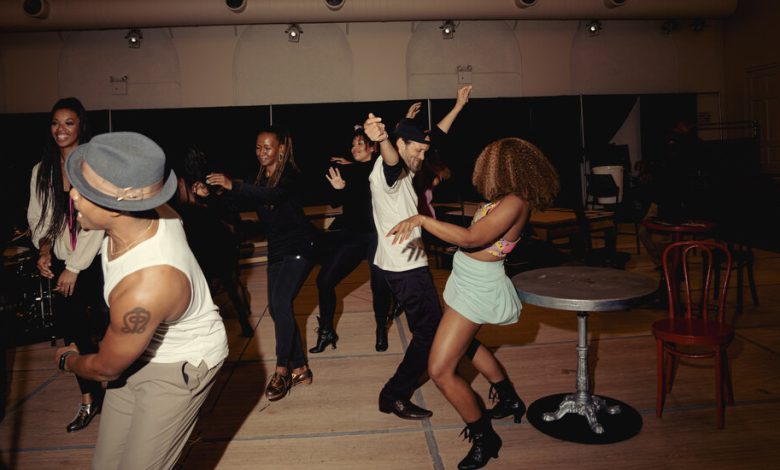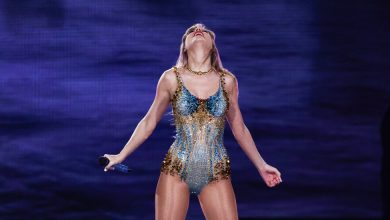Joey Evans Is Back. This Time He’s a Struggling Artist.

Joey Evans is a charming cad, a heel, an unapologetic womanizer, a gigolo. He’s a second-rate nightclub entertainer who breaks the heart of an ingénue and seduces a rich older woman, trading sex for money.
In 1940, some people found Joey, the protagonist of the 1940 Rodgers and Hart musical “Pal Joey,” repellent. “Can you draw sweet water from a foul well?” Brooks Atkinson famously wondered in his review for The New York Times.
In the decades since, though, the main charge against the show hasn’t been foulness so much as incoherence. Production after production — the last one on Broadway was in 2008 — has attempted to rescue a handful of great Rodgers and Hart songs from the weak book that John O’Hara cobbled together from some of his demotic short stories published in The New Yorker.
Seven years ago, the director Tony Goldwyn — best known as an actor — decided to try his hand at a rescue operation. He brought in the screenwriter Richard LaGravenese, and together they came up with an idea: What if Joey were a gifted, struggling artist? That way, it wouldn’t just be a story of sex and betrayal but also one of art versus ambition. After a few readings, though, that twist didn’t seem reason enough for a revival, so they added another: What if Joey were Black?

Ephraim Sykes, who plays Joey Evans, with Marshal Davis, left, and Glover. “Playing this part has been freeing,” Sykes said. “Music is the lifeblood of this man, and it just so happens that one of his instruments is his body.”Credit…Amir Hamja/The New York Times
To tell that story, Goldwyn and LaGravenese, who are white, felt they needed Black collaborators, which is why their production of “Pal Joey,” opening at New York City Center on Nov. 1, is co-directed by Goldwyn and the tap dancer Savion Glover, who also did the choreography; and has a new book by LaGravenese and Daniel Beaty.
The new story, set in the 1940s, is, as Beaty put it, “about the evolution of a Black artist” — a forward-thinking jazz singer — “in a world where there was no space for him to be his authentic self and what that costs him.” This is a story, he added, with contemporary relevance: “We’re still wrestling with a world where those the system has not been built for are fighting to have a voice.”
It was Beaty’s idea to add some characters who would have been very surprising in any previous production of “Pal Joey” — Black ancestral spirits called the Griots. “At the start of the show, we have this character who is brokenhearted because of the absence of space for him,” he said, “but these ancestors appear, like an energy that lives within him, and give him some hope.”
Those ancestors appear in the form of extraordinary tap dancers, including Dormeshia and Glover. And they keep reappearing throughout the show to remind Joey of his authentic self. This Joey, played by Ephraim Sykes, has a soul, and that soul expresses itself in the deeply rooted sound of Savion Glover’s tap dancing.
The Griots are “a connection to something very old,” Beaty said. “The artists who have danced, sang and acted this path before. I have sat with many of them: Ossie Davis, Sidney Poitier, Harry Belafonte. Ruby Dee told me, ‘We have always had to dance with a gun at our feet, but still we must dance.’”
Glover, too, has always been an artist attuned to his ancestors, especially the veteran tap dancers who mentored him when he was a child. His solo shows can feel like séances, his jazz improvisations quoting those dead teachers and summoning their spirits. “Those Griots could be Jimmy Slyde, Lon Chaney, Chuck Green and Buster Brown,” he said, listing four hoofer-mentors he celebrated in the 1996 Broadway musical “Bring in ‘Da Noise, Bring in ‘Da Funk,” for which he won a Tony Award for choreography.
“Wherever I am, they will be,” he added. “They walk with me.”
And not just in the Griot sections. At a recent rehearsal of one of Joey’s nightclub numbers, Glover stressed that he was stealing a rhythm from Henry LeTang, who choreographed “Black and Blue,” the 1989 Broadway show in which a teenage Glover shared the stage with Slyde, Chaney and other tap masters.
“I appreciate the platform for dance to be part of the storytelling,” Glover said. “But if I have a side agenda, it would be to remind people of the contribution of those old cats.”
The first Joey, in 1940, was a then-little-known Gene Kelly, who vaulted from the part into Hollywood fame. Frank Sinatra played Joey for the sanitized 1957 film. Revivals at City Center in the 1960s starred Bob Fosse, years before he directed shows like “Chicago” that made Joey’s sleaze into a dominant style.
But Beaty and Glover are connecting “Pal Joey” to another history, another well. Like many productions Glover has been involved with — from “Jelly’s Last Jam” in 1991 to the 2016 reimagining of “Shuffle Along” — this “Pal Joey” is concerned with the transformations of jazz.
In the years after the premiere of “Pal Joey,” Rodgers and Hart’s last show together, jazz artists, more than any others, kept the songs of Rodgers and Hart alive, as ground for improvisations. This production’s new story has the benefit of justifying the inclusion of more of those songs. Along with eight from the original, including “Bewitched, Bothered and Bewildered” and “I Could Write a Book,” this “Pal Joey” borrows 15 from other Rodgers and Hart shows, standards like “My Funny Valentine,” “Where or When,” “This Can’t Be Love” and “The Lady Is a Tramp.” Musically, the show is now a Rodgers and Hart songbook, rearranged by Daryl Waters and Glover.
But the production’s jazz approach, evident in each number, is about more than just musical style. “Savion lives in the realm of possibility,” Goldwyn said. “Like: ‘Let’s not nail this down. Let’s see what it might begin to become.’ That creates an environment of constant discovery. It’s very fertile.”
“We’re trying to create creation,” Glover said. “We want the audience to feel it is happening, like they’re at the club.”
That kind of improvisational freedom requires a particular cast, especially a particular Joey. Sykes, who played David Ruffin in “Ain’t Too Proud,” the 2019 Broadway musical about the Temptations, trained as a dancer at the Alvin Ailey school.
“I always spoke first with my body,” he said. “Learning to act standing still is something I’m still learning. Playing this part has been freeing. Music is the lifeblood of this man, and it just so happens that one of his instruments is his body.”
Working with Glover, Sykes said, “is a master class, to put it lightly. He operates on such a different plane of thinking. He’s always pushing me past what I thought was my limit, and we’re all being pushed to create jazz, to make a different show every night.”
A new character, a club owner named Lucille, is played by Loretta Devine, who was in the original cast of “Dreamgirls” in 1981. “She’s the closest to the language we’re trying to summon,” Glover said. “She’s the living proof.”
LaGravenese said that the addition of the Lucille character, “the one closest to the ancestors,” was part of an idea to surround Joey with strong women. Linda, the ingénue, is now a confident equal, played by Aisha Jackson. Joey’s relationship with Vera, the rich older woman, played here by Elizabeth Stanley, is now interracial, which raises the stakes, but Vera’s character is also more complex.
“In some earlier workshops, our Vera was the beautiful Marin Mazzie,” LaGravenese said. “And Marin” — who died in 2018 — “said ‘What if Vera really loves Joey?’ And that opened up another door to making her more human.”
“Marin is an ancestor now, too,” Beaty said. “I think the energy we’ve been feeling in the rehearsal room is the presence of the ancestors. In the cultures I come from, Ghanaian and Cherokee and Blackfoot, we believe that when you invite in the ancestors, they show up.”




